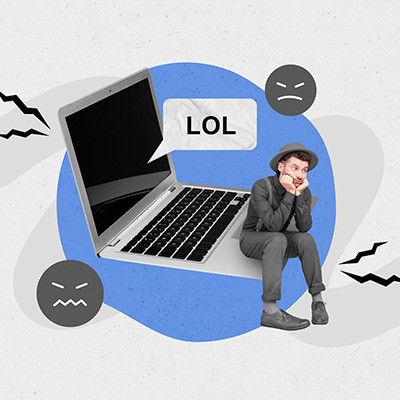The Internet of Things is everywhere and that means that it’s important to understand how much of a potential security risk these devices can be. From smart speakers to smartphones, it's important that you understand how these devices can create problematic situations. In this week’s blog we will discuss how you can protect yourself against IoT vulnerabilities at home.
Telesys Voice and Data Blog
I was meeting with an old colleague the other day. We met over Microsoft Teams to just check in and see how they were doing—no real itinerary, just to check in with a familiar face that I haven’t personally talked to in a few years. They had a little trouble getting into Microsoft Teams, since they were used to Zoom. I patiently smiled and helped them through it, and told them “No worries, it’s always the little differences that complicate things!”
At the time, I said this just to be empathetic. At first, the nerdy computer-geek part of my brain told me that the process to get into a Zoom meeting vs a Teams meeting, from their perspective, is exactly the same. But after the call, I really thought about this small interaction, and you know what? Things have gotten complicated.
Anyone who wants to prioritize their privacy should be aware of the role the cache plays in such a thing. Your Google web browser—even on your smartphone—will store information about what you search so it can personalize your ads and recommendations, but if you would rather not have it do this all the time, you can clear your Android device’s Google search cache and set it up to auto-delete after a set amount of time has passed.
Smartphone applications are in high demand from both a consumer and a business perspective, so it stands to reason that these ecosystems are large in scope, encompassing millions of apps on both the Google Play and Apple App stores. Have you ever wondered how these companies ensure that the apps found on their stores are secure and legitimate?
Business technology has grown so much over time that it’s practically unrecognizable compared to some of the original solutions. The Internet of Things has given businesses more opportunities to automate processes and build efficiency into their IT infrastructure, and in more ways than one. Let’s look at how businesses use the Internet of Things and what you might accomplish with it.
More than ever, it is important for your employees to have positive work experiences. People have many more resources to find new work today, and with so many people willing to find the “right fit” it can be quite expensive for organizations. While the best way is always to compensate people well, if you are facing a situation where you need to be creative to keep your people around, we have three suggestions.
Whether or not you believe acronyms are an acceptable form of speech, some people might use them habitually or instinctively even for business communications. Of course, they don’t have much place in this context, but habits are hard to break. To address this issue, one innovative thinker has created a tool that can help determine if the acronym “LOL” is sincere or not.
Not everyone is cut out to be an entrepreneur, largely because there’s a lot that can pop up and cause problems that need to be addressed. Let’s discuss how successful business owners rally through tough times to help attain this kind of success.
It probably isn’t hard to think of a time when you’ve stumbled across something that would be useful for work while you were doing some personal browsing. What if I told you there was an easy way to send a website to your browser to view later? Thanks to Google Chrome, this is the case.
Do your employees have a hard time with the technology that you’ve provided them? Are your digitization efforts lagging behind? Are the systems your business is using coming up on their end of support date? Old technology can cause major problems for a business. In this week’s blog, we go through some of the signs that you may need to upgrade your business’ technology.
With technology playing such a massive role in modern business processes, having someone in the higher ranks to oversee it is a huge advantage. This is the role of the Chief Information Officer—the CIO—which makes them an integral part of the modern C-suite.
So, what kind of thing does the CIO (or your business’ equivalent of it) need to know and consider in order to fulfill their role?
For millions of people, the rubber ducky is a benign reminder of childhood. Depending on when you were a child, the rendition of Sesame Street’s Ernie singing “Rubber Duckie, you’re the one,” is ingrained in your mind every time you hear the term. Unfortunately, the Rubber Ducky we are going to tell you about today has only fond recollection for people who are looking to breach networks they aren’t authorized to access or deliver malware payloads that are designed to cause havoc.
WhatsApp is one of the world’s most popular messaging applications. With over 2 billion users, WhatsApp is known for its relative security, as it is one of the few messaging applications that offers end-to-end encryption. A modified version of WhatsApp, called YoWhatsApp, has been reportedly deploying malware.
How often does this scenario happen to you? You’re going about your workday and are being quite productive, when all of a sudden you close the wrong tab in your web browser, putting an end to your productivity. This isn’t crippling downtime or anything, but it’s an inconvenience that we know you can do without. Thankfully, modern web browsers let you reopen closed tabs or windows to get back to where you left off.
In efforts to curb the semiconductor shortage and jumpstart the technology industry, the United States Congress passed legislation that includes funding for manufacturing semiconductors. Partially in response to China’s increasing economic influence and partially in response to the semiconductor shortage, the CHIPS Act could be just what industry leaders need to kickstart the manufacturing of these important devices.
At the beginning of September, it was revealed that a relatively simple issue existed in nearly 2,000 mobile applications that potentially exposed some (read: a lot of) sensitive data. Let’s take a brief, basic look at the situation to see if there are any lessons that can apply to your business.
The average person will spend an estimated one-third of their life at work. One third. That’s a lot of time, providing plenty of opportunity to accumulate stress. Over time, these emotions could potentially overwhelm your employees and lead to a breakdown. This is, naturally, harmful to your business, so let’s explore some strategies you can share with your team to help them deal with their workday stresses.
It’s easy to use the terms “patches” and “updates” as if they mean the same thing, and they are often used interchangeably within the same context. However, understanding the difference between the two can make a world of difference in terms of how you approach implementing each of them. We’re here to clear things up a bit and help you better understand the patches and updates you deploy on a month-to-month basis.
Running a business is stressful, but so is thinking about a future where that business (and its data) no longer exists. If you’re not careful with your preparedness, you could stare down a disaster with no hopes of recovery. This is why we urge you to take proactive action now—so you can prevent these kinds of scenarios from taking your business off the market for good.
I feel like we’ve been talking a lot about the horrifying cybersecurity threats that loom over our heads, and thought it might be nice to really appreciate just how gosh-darn cool some of these devices we all have can be instead.
Mobile? Grab this Article!
Tag Cloud




















